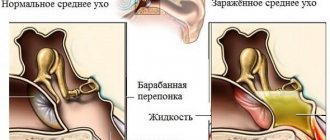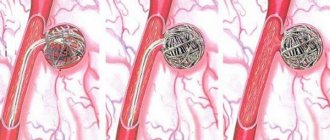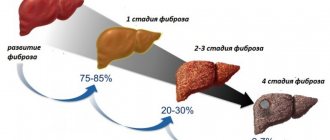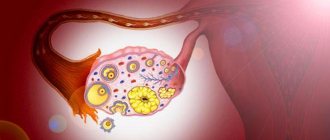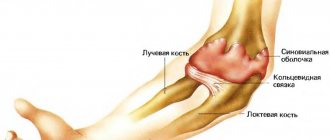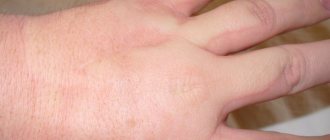A common benign growth filled with a clear, jelly-like fluid is called a liver cyst. The pathology was assigned a code according to ICD-10 “Other liver diseases”. There are 2 types of cysts - parasitic and non-parasitic, each of which manifests itself with severe symptoms. When such a tumor is detected, removal surgery is often prescribed; small cysts are treated with medication.
Main causes
A parasitic cyst in the liver occurs as a result of human infection with parasites echinococcus or alveococcus. The true causes of the non-parasitic form have not been fully studied, but predisposing factors under the influence of which the disease progresses have been identified. Common reasons include:
- violation of the formation and development of the liver during intrauterine growth;
- genetic predisposition;
- uncontrolled use of hormone-containing drugs;
- severe injuries, complications after surgery;
- obstruction of the bile ducts;
- inflammatory diseases affecting liver tissue.
Reasons for the appearance of education
The appearance of a cyst in the right lobe of the liver or in its left part is provoked by the following negative factors:
- hereditary predisposition;
- inflammatory processes in the organ due to its parasitic infection;
- injury to an organ, surgical intervention on it;
- hormonal imbalance;
- alcohol or drug abuse;
- polycystic kidney or pancreatic disease;
- prolonged intoxication of the body;
- intrauterine organ development disorder;
- cirrhosis of the liver.
There are many reasons for the development of education, including cholelithiasis that can give impetus to the development of such a disease.
Parasitic infection of the organ can lead to the formation of liver cysts. After surgery, cysts can sometimes form on the liver. Hormonal imbalance can lead to various changes in the body, sometimes to the appearance of cystic liver cavities. Intoxication due to improper use of drugs and alcohol abuse will certainly affect the state of the body’s “main filter”.
Varieties
Cysts can form in any segment of the organ, but most often a tumor is diagnosed in the left lobe, while a cyst in the right lobe of the liver is extremely rare.
The nature of the cyst is determined by an abnormal development of the liver or infection by parasites.
There are multiple cystic formations or a single tumor is formed. There is a separate classification based on etiological origin. There are 2 types here:
- Non-parasitic cyst, which, in turn, is divided into the following forms: False. They arise as a result of injury to an organ or the occurrence of an inflammatory-infectious pathology.
- True. They are formed during the period of intrauterine development. The following forms are distinguished: simple solitary;
- polycystic disease;
- congenital liver fibrosis.
- echinococcal;
Types of neoplasms
Oncologists adhere to a certain classification of cystic tumors. First of all, they stand out:
- True. It is distinguished by its congenital nature and the presence of a specific “lining” inside the epithelial layer.
- False. Appears under the influence of external factors - liver injury, surgery, inflammation. In this case, the soft tissues of the organ undergo changes, which becomes a provocateur of a benign formation.
Depending on the structure, it is diagnosed:
- A simple liver cyst is a single tumor.
- Multi-chamber - the internal space is divided by partitions.
- Polycystic disease is a small cystic formation that affects one area or different segments.
The most general classification divides all cystic formations into:
- parasitic (echinococcal, alveococcal);
- non-parasitic.
When the liver is damaged by helminths and specific cavities form, it is important to prevent the spread of parasites through the bloodstream to other organs.
What symptoms are you worried about?
Small cystic tumors often do not cause any characteristic symptoms and do not affect a person’s health. However, if the formation begins to grow, reaching a size of 5 cm or more, the patient begins to be bothered by the following symptoms:
- Discomfort or aching pain localized on the right, near the navel or in the epigastric region. After eating heavy food or alcohol, the pain begins to get worse.
- Nausea, attacks of vomiting and heartburn.
- Intestinal upset, pain, flatulence, increased gas formation.
- Loss of appetite, weight loss.
- Increased sweating, shortness of breath.
- Increased body temperature, yellowness of the whites of the eyes and skin.
Cysts of a parasitic nature are dangerous. The growing tumor compresses the bile ducts, contributing to the development of obstructive jaundice. Symptoms of an allergic reaction also appear:
- rash;
- itching;
- swelling;
- irritation of mucous membranes.
A growing parasitic cyst can become damaged at any time. Rupture of the tumor provokes hepatomegaly, peritonitis, in which the patient has severe abdominal pain, pulse and blood pressure drop, breaks into a cold sweat, and deep fainting is possible. To prevent such dangerous consequences, it is important to diagnose the problem in a timely manner and begin treatment as soon as possible.
Complications
A complicated course of a liver cyst develops with hemorrhage into its wall or cavity, suppuration, perforation, torsion of the cyst leg, or malignant degeneration. When hemorrhage, rupture of the cyst or breakthrough of its contents into adjacent organs, an acute attack of abdominal pain develops. In these cases, there is a high probability of bleeding into the abdominal cavity and peritonitis. When nearby bile ducts are compressed, jaundice appears, and when infected, a liver abscess forms.
Echinococcal cysts of the liver are dangerous due to the spread of parasites by hematogenous route with the formation of distant infectious foci (for example, echinococcal cysts of the lung). With widespread polycystic liver disease, liver failure may develop over time.
To the question “can a cyst in the liver resolve?” - It’s quite difficult to answer. This is possible if you remove the negative factors that provoke it. Also, it itself disappears if its size is not very large, and it is not caused by parasites, or is not congenital.
The prognosis, with timely treatment, is favorable. However, in some cases, the pathology can recur and cause complications:
- formation of purulent contents inside the neoplasm;
- internal bleeding due to cyst rupture;
- spread of parasites throughout the body;
- liver failure.
With timely treatment, the risk of complications is minimal.
Diagnostics
To confirm or refute the presence of a cyst, a number of studies are prescribed.
When growing cystic neoplasms hurt and constantly bother a person, it is necessary to make an appointment with a hepatologist. Using palpation, the doctor will be able to establish a preliminary diagnosis. After the initial examination, a more detailed diagnosis is carried out, which primarily includes an ultrasound of the liver. On the monitor, a liver cyst looks like a limited cavity, inside of which there is a liquid substance.
Additionally, more informative instrumental research methods are prescribed - MRI, CT, scintigraphy, angiography, which will help exclude malignant tumors, cystic fibrosis, hemangioma, neoplasms in the small intestine, pancreas, and kidney cysts. A specific serological blood test - ELISA, RNGA - will help to identify a parasitic cystic formation.
Signs
Scientists note that there are no nerve endings in the vital organ, so the first signs in most cases may not be noticed. As a rule, a tumor makes itself known only when it grows to 8 centimeters, or when the volume of the abdomen increases, or, for example, when a blood test is taken.
At a later stage of development of a cyst in the organ, signs of the disease can be identified such as:
- the appearance of a dull pain in the area of the right side or navel,
- diarrhea,
- gagging,
- loss of appetite,
- general malaise and shortness of breath,
- jaundice,
- sudden weight loss,
- increase in the size of the abdominal cavity.
To a lesser extent, the presence of a cyst can be determined by palpation, that is, during an examination by a doctor. But most often, if at least one of the signs listed above appears, the doctor will send his patient for an ultrasound and CT scan in order to confirm or refute his fears about establishing this diagnosis.
If the cyst is small, the patient may have no symptoms. Sometimes a tumor is accidentally discovered during an ultrasound examination of the abdominal organs.
If the cyst is large and begins to put pressure on neighboring organs, the following symptoms may occur:
- frequent nausea;
- feeling of heaviness in the stomach;
- pain on the right side of the abdomen, which tends to intensify with physical stress;
- discomfort after eating;
- heartburn.
Heartburn is one of the possible signs of a liver cyst.
Finally, during the examination, the doctor may notice that the patient's liver is enlarged.
If the contents of the cyst become infected, the patient may experience symptoms of body intoxication: fatigue, lack of appetite, weakness, tachycardia. Also in the evenings, the patient’s temperature increases (up to 37-37.5 degrees).
Treatment of pathology
Drugs
If a diagnostic study reveals microcysts or a small liver cyst not exceeding 3 cm in diameter, the doctor will advise treating the problem conservatively or simply observing the formation. Drug therapy will help maintain liver health, with the help of which it will be possible to normalize the functioning of the organ and strengthen the immune system. The treatment regimen and drug groups are selected individually. It is forbidden to buy and take medications at your own discretion, because this will not cure the cyst.
Surgery
If the cyst on the liver is constantly growing, and conservative methods do not help stop the progression of the pathology, the doctor will recommend surgery. The following types of surgical treatment exist:
- desquamation of cystic contents and its membrane;
- excision of the affected organ segment along with the tumor;
- removal of the walls of the tumor.
After surgery, pharmaceuticals are prescribed.
If radical resection is contraindicated, minimally invasive laparoscopic removal is prescribed. Indications for this type of surgery:
- ruptures, internal hemorrhage;
- purulent contents of the cyst;
- if the cysts grow rapidly and exceed the size of 9 cm;
- high probability that the tumor will become malignant;
- biliary dysfunctions;
- frequent relapses;
- severe symptoms.
What should the diet be like?
Cystic disease is treated comprehensively, therefore, in addition to drug and surgical therapy, it is necessary to establish nutrition, which will relieve the organ and prevent the development of complications. All food should be prepared using a gentle method, without adding spices, seasonings, or hot sauces. It is useful to enrich your diet with foods that contain many vitamins and beneficial elements. In order for the diet for liver cysts to be effective, it is recommended to follow these rules:
- Eat more fresh fruits and vegetables, limit fatty, fried, sweet foods as much as possible.
- Control the ratio of proteins, fats, carbohydrates in the diet.
- Eat often, but in small portions.
- On average, the daily diet in terms of energy value should not exceed 3 thousand kcal.
Traditional methods
Treatment of liver cysts with folk remedies can be carried out only when the neoplasm is in a stable condition, does not cause any symptoms and does not threaten health. In order for the microcyst to resolve, it is recommended to use burdock, or rather, its juice, which is prepared according to this recipe:
- Wash the young leaves of the plant, dry with a paper towel, and then pass through a meat grinder.
- Place the resulting pulp in cheesecloth and place a press on top.
- Drink 2 tbsp of ready-made juice. l. every time before the main meal.
- After preparation, the liquid can be consumed within 3 days, after which a new portion can be prepared.
A small cyst can resolve if you use celandine tincture. It's easy to prepare:
- Finely chop the fresh plant, pour half into a liter container, and add the rest of the volume with alcohol or vodka.
- Leave the product to infuse in a dark place for 25 days.
- Take the finished tincture 10 drops. per day for a course of 1 week. Afterwards take a 20-day break and repeat treatment if necessary.
General strengthening medications help cope with the disease.
You can increase your immunity and improve the functioning of your liver if you drink rosehip decoction every day. The drink is prepared according to the following recipe:
- Pour 2-3 tbsp. l. rose hips with boiling water in the amount of 700 ml.
- Place the container with the contents in a steam bath, cover with a lid and simmer for 15-20 minutes.
- Cool the finished product to room temperature and strain.
- Take during the day as tea, you can add a little sugar or honey to taste.
Other useful remedies to help fight liver cysts:
- tincture of pine nut shells;
- beech decoction;
- bedstraw infusion.
The importance of diet therapy for liver cysts
A person should eat properly not only when clinical symptoms of the disease appear, but also outside the acute period. Even a small volume of the cyst can disrupt the functioning of the gland, and therefore maximum unloading and support of the liver is necessary. Diet therapy requires adherence to certain rules. The menu is drawn up exclusively by a specialist, taking into account the severity of the pathology, allergic predisposition and the presence of concomitant diseases in the patient. An important nuance is taste preferences.
Depending on the stage of the disease, the doctor may adjust the diet. If there are pronounced symptoms, a strict diet is prescribed. The patient must follow the general principles of nutrition throughout his life (refusal of fatty, fried foods, as well as spicy seasonings). As for strict restrictions, they are temporary, usually lasting no longer than a few months. They imply exclusively steam cooking, grinding the consistency of dishes and avoiding foods with coarse fiber.
Why is a cyst dangerous?
The danger of such a tumor is that it can grow in size and quantity. In this case, there is a high risk of developing complications such as:
- rupture of the formation and release of fluid into the peritoneal cavity;
- internal bleeding;
- the addition of a bacterial infection with further intoxication of the body;
- hepatomegaly.
If a parasitic cyst is damaged, the parasites, along with the bloodstream, are spread throughout the body, affecting new organs and causing additional complications. An expanded tumor is often accompanied by jaundice, exhaustion, and pathological enlargement of the abdomen. Such symptoms indicate that the disease is advanced, so delaying a visit to the doctor is dangerous.
What is a neoplasm
In the photo, the cyst is represented by a focal cavitary neoplasm, which is filled with liquid contents and lined with columnar or cubic epithelium. There are also so-called false cysts, their difference from true ones is that they do not have their own wall - their wall is the altered liver tissue.
Usually the contents of the cystic cavity are transparent and colorless; in more rare cases, the neoplasm is filled with liquid or a jelly-like mass, which may have a brownish and/or greenish tint. When there is hemorrhage into the cyst, the contents become hemorrhagic, and when an infectious process develops, it becomes purulent.
Cystic formations can occur in various segments and lobes of the organ and reach large sizes (25 cm in diameter or more). As a rule, cysts of the left lobe of the liver develop more often. The cystic cavity can be localized on the surface or inside the organ, that is, its location can be subcapsular or parenchymal (intraparenchymal).
Prevention and prognosis
If the cyst is surgically removed, the risk of relapse is minimized, so the prognosis for a full recovery is favorable. Progressive pathology leads to dangerous complications. If kidney failure occurs, the situation will end in death.
There are no specific recommendations for the prevention of pathology. It is important to maintain the health of the whole body, monitor nutrition, and get rid of bad habits. To prevent infection with parasites, you should follow the rules of personal hygiene, wash fruits and vegetables before eating, and take anthelmintic drugs as a preventive measure.
Stages of development of a parasitic cyst
Before treating a liver cyst, it is necessary to consider the stages of its development. This determines whether a person needs to take medications or undergo surgery.
Since parasitic liver damage accounts for the majority of all cystic formations, we will consider the stages of progression of the disease using its example:
- First stage. Parasites have penetrated the organ, they have begun their destructive effect, a small part of the toxins penetrates the blood. At this stage, the defenses are able to maintain normal body functionality. There are practically no symptoms here.
- Second. The tumor grows and soon begins to put pressure on the organ, causing pain; waste products of foreign organisms are already entering the bloodstream more, so nausea, dizziness, etc. are possible.
- Third. The cyst progresses quite quickly. If you do nothing, the inflammatory process begins and the formation begins to fester. In this case, the risk of organ rupture increases. Poisoning of the body with toxins may occur, which makes itself felt by vomiting, fainting, fever, etc.
Regardless of the cause of the disease, it needs to be monitored. At the first signs of changes (growth of formation, changes in content, inflammation of adjacent tissues, etc.), appropriate therapeutic measures must be taken.
If we talk about the appearance of parasitic formations, then their causes have been known to medicine for a long time. They are formed due to infection of the body by certain types of parasites. But if we talk about non-parasitic types, their development still causes controversy and debate.
According to doctors, the reasons for this can be quite different. So, this may be hyperplasia of the hepatic tract even during embryonic development. In addition, the cause may be diseases of the interlobular gastric tracts, as well as regular use of various hormonal drugs. In addition, pathology may appear due to injuries or liver diseases. Sometimes this can be caused by an unsuccessful operation or the presence of an inflammatory process in the organ.
Therapeutic measures
If a cystic tumor is detected in the liver, what to do? Take action immediately! When contacting a medical institution, a qualified specialist will provide maximum information about such a pathological phenomenon as a cyst, the causes and signs of the disease.
In order to understand how to treat a cyst in your particular case, the doctor needs to determine the type of formation and make the correct diagnosis.
In the presence of a cyst-like neoplasm, as well as after its removal, the specialist prescribes various medications to maintain liver function and strengthen the body’s defenses. It is necessary to take such medications strictly according to the prescribed regimen; due to exceeding the recommended dose and violating other doctor’s recommendations, not only the liver, but also the entire body as a whole may stop functioning normally.
Most often, surgery is used to treat this tumor. This is explained by the fact that a large parasitic formation can rupture and cause hemorrhage and infection. In addition, against the background of a progressive disease, liver function is often impaired and organ atrophy develops, and the liver parenchyma can be replaced by cystic neoplasms.
If the cystic formation in the liver does not exceed 3 cm, there is no need for surgical intervention, except in cases of obstructive jaundice.
If the tumor is larger than 5 cm, it is removed surgically.
